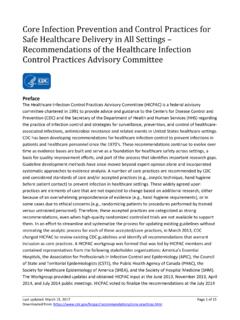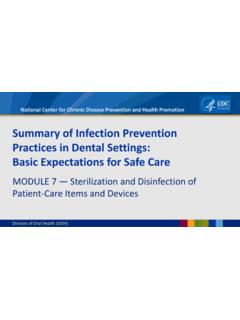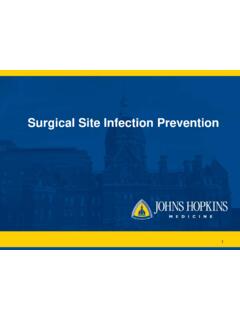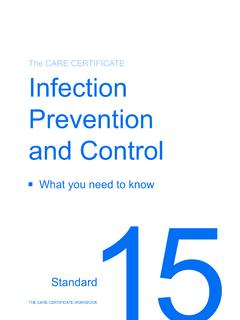Transcription of Protocol for surgical site infection surveillance with a ...
1 Protocol for surgical site infection surveillance with a focus on settings with limitedresourcesProtocol for surgical site infection surveillance with a focus on settings with limited resources ISBN 978-92-4-156554-7 World Health Organization 2018 Some rights reserved. This work is available under the Creative Commons Attribution-NonCommercial-ShareAlike IGOlicence (CC BY-NC-SA IGO; ).Under the terms of this licence, you may copy, redistribute and adapt the work for non-commercial purposes, provided thework is appropriately cited, as indicated below. In any use of this work, there should be no suggestion that WHO endorsesany specific organization, products or services.
2 The use of the WHO logo is not permitted. If you adapt the work, then youmust license your work under the same or equivalent Creative Commons licence. If you create a translation of this work, youshould add the following disclaimer along with the suggested citation: This translation was not created by the World HealthOrganization (WHO). WHO is not responsible for the content or accuracy of this translation. The original English edition shallbe the binding and authentic edition .Any mediation relating to disputes arising under the licence shall be conducted in accordance with the mediation rules of theWorld Intellectual Property citation.
3 Protocol for surgical site infection surveillance with a focus on settings with limited resources. Geneva:World Health Organization; 2018. Licence: CC BY-NC-SA (CIP) data are available at , rights and purchase WHO publications, see To submit requests forcommercial use and queries on rights and licensing, see you wish to reuse material from this work that is attributed to a third party, such as tables, figuresor images, it is your responsibility to determine whether permission is needed for that reuse and to obtain permission fromthe copyright holder. The risk of claims resulting from infringement of any third-party-owned component in the work restssolely with the designations employed and the presentation of the material in this publication do not imply theexpression of any opinion whatsoever on the part of WHO concerning the legal status of any country, territory, city or area orof its authorities, or concerning the delimitation of its frontiers or boundaries.
4 Dotted and dashed lines on maps representapproximate border lines for which there may not yet be full agreement. The mention of specific companies or of certain manufacturers products does not imply that they are endorsed orrecommended by WHO in preference to others of a similar nature that are not mentioned. Errors and omissions excepted,the names of proprietary products are distinguished by initial capital reasonable precautions have been taken by WHO to verify the information contained in this publication. However, thepublished material is being distributed without warranty of any kind, either expressed or implied.
5 The responsibility for theinterpretation and use of the material lies with the reader. In no event shall WHO be liable for damages arising from its use. Designed by CommonSense, GreecePrinted by the WHO Document Production Services, Geneva, Switzerland3 Protocol FOR surgical SITE infection surveillance WITH A FOCUS ON SETTINGS WITH LIMITED RESOURCESC ontentsAcknowledgments .. 4 Acronyms .. 4 Glossary of 51. 72. Purpose of this document and target 83. surgical site infection surveillance overview .. 94. Definitions and risk factors for surgical site infection surveillance .. 115. The WHO approach to surgical site infection surveillance , with a focus on settings with limited resources.
6 Setting up a surveillance team .. Establishment of support Enrolment into surveillance .. Peri-operative data Post-operative data collection .. Data Other important considerations for successful surgical site infection surveillance .. 166. Analysis of surveillance data .. 197. Interpretation and feedback of surveillance 208. References .. 229. Annexes .. 23 Annex 1: United States Centers for Disease Control and prevention National Healthcare Safety Network surgical site infection definition criteria .. 23 Annex 2: WHO peri-operative data collection form .. 25 Annex 3: Additional detailed information on completing the WHO peri-operative data collection 27 Annex 4: WHO post-operative data collection form.
7 31 Annex 5. Additional detailed information on completing the WHO post-operative data collection form .. 33 Annex 6: Example of a script for post-discharge telephone follow-up .. 374 Protocol FOR surgical SITE infection surveillance WITH A FOCUS ON SETTINGS WITH LIMITED RESOURCESThe World Health Organization (WHO) would like to express its sincere appreciation and gratitude toall those who have supported and contributed to the development of this Protocol was initially developed in the context of the surgical Unit-based Safety Programmeimplementation in African hospitals ( )and revised thereafter.
8 Therefore, WHO would like to thank all those who used the Protocol andprovided feedback on its feasibility and usefulness in the context of a strategy to improve infectionprevention measures and to reduce the risk of surgical site infections . In particular, we acknowledgethe efforts of Peter Nthumba, Jack Barasa, Carol Mwangi, Joseph Nyagah, and Serah Nyaga (KijabeHospital, Kijabe, Kenya), Gabriel Okumu, Robert Mugarura, Agness Katwesigye (Kisiizi Hospital,Kisiizi, Uganda), Alexander Elobu, Josephat Jombwe, Dorah Nakamwa (Mulago Hospital, Kampala,Uganda), and Mayaba Maimbo, Joseph Musowoya, Margaret Kasepa and Chitundu Mbao (NdolaCentral Hospital, Ndloa, Zambia).
9 Development groupBenedetta Allegranzi (Service Delivery and Safety, WHO), Alexander Aiken (LondonSchool of Hygiene and Tropical Medicine, London, United Kingdom), Claire Kilpatrick (ServiceDelivery and Safety, WHO).ReviewersJolanta Griskeviciene (Service Delivery and Safety, WHO) and Sara Tomczyk (Robert Koch Institute,Berlin, Germany).Editing and designingRosemary Sudan and Revekka supportAgency for Healthcare Research and Quality, United States of handrubASAA merican Society of Anesthesiologists CDC-NHSNC enters for Disease Control and prevention National Healthcare Safety NetworkGNI gross national incomeHAIhealth care-associated infectionIPCinfection prevention and controlLMIClow- and middle-income countriesNNISN ational Nosocomial infection SurveillanceSSIsurgical site infectionSUSPS urgical Unit-based Safety ProgrammeUSAU nited States of AmericaWHOW orld Health OrganizationAcronymsAlcohol-based handrubrefers to an alcohol-based preparation designed for application to thehands to inactivate microorganisms and/or
10 Temporarily suppress their growth. Such preparationsmay contain one or more types of alcohol, other active ingredients with excipients and American Society of Anesthesiologists (ASA) score is a classification system used tomeasure a patient s pre-operative physical condition. Together with other parameters it is used toevaluate the patient s risk of acquiring infection . Class I: A normally healthy patient. Class II: A patientwith mild systemic disease. Class III: A patient with severe systemic disease that is notincapacitating. Class IV: A patient with an incapacitating systemic disease that is a constant threat tolife.















